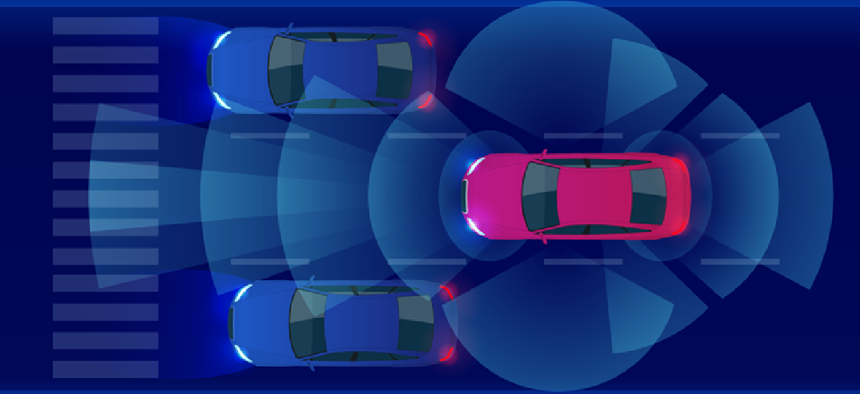What's next for V2X spectrum?


Connecting state and local government leaders
A high-stakes policy debate among automakers, governments and telecommunications firms over the spectrum for vehicle-to-everything communications may eventually be solved by market forces.
As the partial government shutdown began in late December, the Department of Transportation published a request for comments on how DOT should approach vehicle-to-everything communications. V2X refers to a suite of technologies that could enable everything from hazard warnings to drivers and pedestrians to high-speed automated road trains. That’s significant enough. But DOT’s second question highlights the current high-stakes policy debate among automakers, governments and telecommunications firms over the future of a band of radio spectrum.
Those frequencies, known as the intelligent transportation system (ITS) band, 75 MHz centered around 5.9 GHz (5.850–5.925 GHz), was allocated by the Federal Communications Commission in 1999 for use by dedicated short-range communications (DSRC) systems. In DOT’s request for comments, the second question asks what should become of the 5.9 GHz band.
Why the high stakes?
The growth of the Wi-Fi market and increasing congestion in the existing unlicensed bands has pitted broadband providers and users against leading automakers such as General Motors and Toyota over access to the 5.9 GHz band. This battle reached a fever pitch in the final days of the Obama administration after the National Highway Traffic Safety Administration (NHTSA) published a proposal to mandate automakers to install DSRC in new light-duty vehicles for the purpose of providing drivers vehicle-to-vehicle hazard warnings.
Critics of the DSRC mandate, including this author, have highlighted its glaring deficiencies in roadside infrastructure management, cybersecurity, interactions with other safety-critical vehicle systems, and benefit-cost estimations. Numerous autonomous vehicle developers weighed in against NHTSA’s proposed rule, arguing that forcing DSRC on the entire light-duty vehicle fleet threatened the prospective safety gains from their automation technologies -- which have the potential to actually intervene in hazardous situations, rather than merely warning human drivers of those hazards’ existence as contemplated by NHTSA.
After the public comment period closed in early 2017, the Trump DOT reversed course. The proposed rule was relegated to long-term action status, which means NHTSA planned no future work for at least 12 months. DOT’s multiyear strategic plan removed previous mentions to vehicle-to-vehicle communications. And in public statements, Department officials from Secretary Elaine Chao on down began emphasizing the new administration’s position of technology neutrality, which could only be interpreted as a dig against their predecessors’ attempt to promulgate a nationwide DSRC mandate.
In the time since, this debate has become even more complicated as other automakers, most notably Ford, have committed to cellular-vehicle-to-everything, or C-V2X, the leading competitor of DSRC. Yet, the 5.9 GHz band remains closed to C-V2X as well as unlicensed Wi-Fi use. Commissioners at the FCC have expressed increasing skepticism of DSRC’s exclusive use of the 5.9 GHz band. It is becoming apparent that the 20-year-old DSRC allocation is unlikely to hold for much longer.
The reason for this shift is, despite the hype, the band has been little used. A 2018 RAND Corporation study estimated that current use of the 5.9 GHz ITS band has a market value of just $6.2 million. In contrast, if the ITS band were to be reallocated and opened to unlicensed Wi-Fi use like the neighboring U-NII-3 Wi-Fi band at 5.725–5.850 GHz, RAND estimates total economic welfare gains of $82.2 billion to $189.9 billion.
The decision over the fate of the 5.9 GHz band ultimately rests with the FCC, but the fact that DOT is even asking this question suggests it is prepared to take a position other than keeping the ITS band DSRC-exclusive, which will carry a great deal of weight with FCC commissioners. Barring a highly unlikely incentive auction of these frequencies, there are two realistic paths forward.
The first, and less likely of the two, is for the FCC to reallocate the 5.9 GHz band for use by U-NII-4 Wi-Fi devices. While there is a strong economic argument for doing so (as the RAND study makes clear), protecting the integrity of safety-critical systems will likely prove more persuasive to policymakers. DOT and the automotive industry will frame any non-ITS use of the band as a threat to human life and property. Preventing deaths on the highway will trump better Wi-Fi.
The second and more likely course of action is for the FCC to reallocate the ITS band to allow for both DSRC and C-V2X. A European proposal from the cellular-supporting 5G Automotive Association sketches out how this would work. Of the 75 MHz at issue, 30 MHz would be split into 10 MHz for DSRC, 10 MHz for C-V2X, and a 10 MHz channel in between to be shared by both under a detect-and-vacate or similar rule. The remaining 45 MHz would be allocated at a later date once a clear market winner emerges.
This second approach would allow DOT to preserve what it views -- incorrectly -- as “its” spectrum band. But it would also comport with the current administration’s pledge of technology neutrality, to allow the marketplace, rather than bureaucrats and lobbyists from dominant firms, to select the appropriate V2X technology.
Additionally, such a proposal would also split the automotive and telecommunications industries, dampening the clout of those seeking DSRC exclusivity or unlicensed wireless. Given our country’s highly polarized political environment, it is somewhat surprising that a compromise position appears to be poised to carry the day, but that appears to be the case with the future of 5.9.
NEXT STORY: Washington's employee wellness portal pays off




